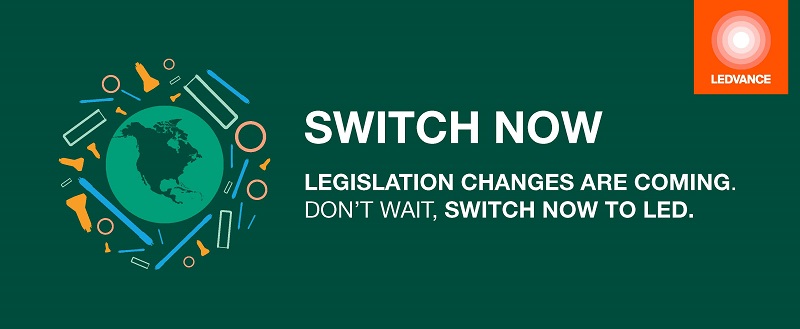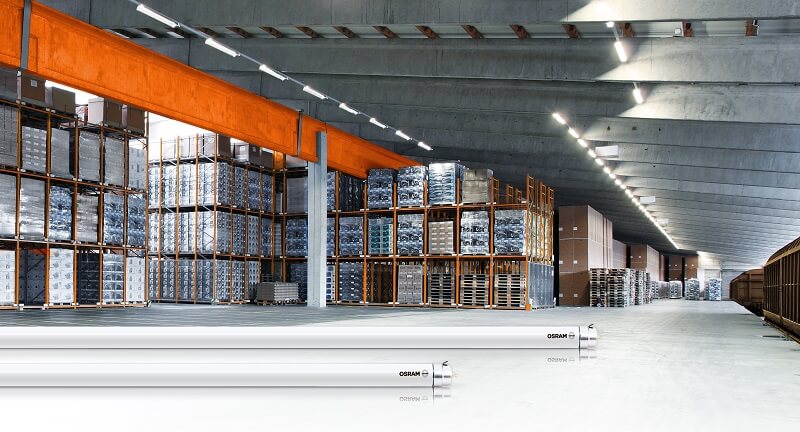Why Fluorescent Bulbs Are on Their Way Out
For a long time, fluorescent tubes have been seen everywhere in homes, offices, and commercial places. Compared with traditional incandescent bulbs, it was once favored for its energy-saving advantage. However, as our understanding of the environmental and health impacts deepens, the drawbacks of fluorescent tubes have gradually come to light.

The Problem of Mercury Pollution
Fluorescent tubes contain harmful substances such as mercury. If not properly handled, they can cause pollution to the soil, water sources and the atmosphere. According to a report by UNEP, millions of fluorescent tubes are discarded worldwide every year, most of which are not safely disposed of, causing serious harm to the environment.
Less Efficient than LED
With the rapid development of LED technology, the energy efficiency advantage of fluorescent tubes has gradually been lost. Modern LED lamps not only consume less energy, but also have higher brightness, faster start-up speed and longer lifespan. Under the same brightness, LED lights can save more than 30% of electricity compared to fluorescent lamps, and their service life can reach 2 to 5 times that of fluorescent lamps.
With the worldwide emphasis on energy efficiency and reducing emissions, LED lights have emerged as a superior alternative.
Recycling Challenges
Although fluorescent lamps are theoretically recyclable, in practice, their slim, fragile design and mercury content make recycling costly and risky. Many areas also lack a complete recycling system, causing a large number of discarded fluorescent lamps to end up in regular waste streams, which worsens environmental pollution.
In contrast, the recycling and processing of LED lamps are more convenient and environmentally friendly. Therefore, in the process of upgrading lighting equipment, countries tend to phase out fluorescent tubes.
Fluorescent Ban Overview
Federal Regulations by DOE
The federal regulations of the U.S. Department of Energy (DOE) are of great significance for promoting the development of the lighting industry. These regulations achieve this by revising the definitions of key terms such as Universal Service Lamp (GSL) and Universal Service Incandescent Lamp (GSIL).
Amend the definitions of GSL, GSIL and the other supplemental definitions.
Required the luminous of commercial fluorescent lamps increased from the original approximately 60-90 LPW to more than 120 LPW.
Phase out fluorescent tubes, including common models such as T8 and T12.
This significantly enhances the luminous efficiency of commercial fluorescent lamps and eliminates common fluorescent tube models, contributing to the construction of a new energy-saving and sustainable lighting ecosystem.
State by State Regulations
As of now, thirteen states have taken banned actions related to fluorescent tubes. Here is a comprehensive, updated chart detailing the status of fluorescent lamp bans across U.S. states.
Summary Table
State
|
Screw-Base CFL Ban
|
Pin-Base CFL Ban
|
Linear Fluorescent Tube Ban
|
High-CRI Fluorescent Ban
|
|
California
|
Jan 1, 2024
|
Jan 1, 2025
|
Jan 1, 2025
|
Jan 1, 2025
|
|
Colorado
|
Jan 1, 2025
|
Jan 1, 2025
|
Jan 1, 2025
|
Jan 1, 2021
|
|
Hawaii
|
Jan 1, 2025
|
Jan 1, 2026
|
Jan 1, 2026
|
Jan 1, 2021
|
|
Illinois
|
Jan 1, 2026
|
Jan 1, 2027
|
Jan 1, 2027
|
-
|
|
Maine
|
Jan 1, 2025
|
Jan 1, 2026
|
Jan 1, 2026
|
July 8, 2021
|
|
Maryland
|
Jan 1, 2025
|
Pending legislation
|
Oct 1, 2024
|
Oct 1, 2024
|
|
Massachusetts
|
Jan 1, 2024
|
Jan 1, 2025
|
Jan 1, 2025
|
OctJan 1, 2022
|
|
Minnesota
|
Jan 1, 2025
|
Jan 1, 2026
|
Jan 1, 2026
|
-
|
|
Nevada
|
Jan 1, 2024
|
Jan 1, 2025
|
Jan 1, 2025
|
July 1, 2023
|
|
New Jersey
|
-
|
-
|
Jan 18, 2023
|
Jan 18, 2023
|
|
New York
|
-
|
-
|
-
|
June 26, 2023
|
|
Oregon
|
Jan 1, 2024
|
Jan 1, 2025
|
Jan 1, 2025
|
Jan 1, 2023
|
|
Rhode Island
|
Jan 1, 2024
|
Jan 1, 2025
|
Jan 1, 2025
|
Jan 1, 2025
|
|
Vermont
|
Feb 17, 2023
|
Jan 1, 2024
|
Jan 1, 2024
|
July 1, 2020
|
|
Washington
|
Jan 1, 2029
|
Jan 1, 2029
|
Jan 1, 2029
|
Jan 1, 2023
|
|
Washington, D.C.
|
-
|
-
|
-
|
Mar, 2022
|
Notice: Certain specialty fluorescent lamps used for specific applications, such as ultraviolet disinfection, image projection, and scientific research, are exempt from this ban.
California
In 2022, California passed AB 2208. It phases out most fluorescent lamps for a greener, healthier future.
Key Dates and Affected Products:
January 1, 2024: Prohibition on the sale and distribution of screw or bayonet base compact fluorescent lamps (CFLs).
January 1, 2025: Extension of the ban to include pin-base compact fluorescent lamps and linear fluorescent lamps (LFLs).
Colorado
Among the timelines for phasing out fluorescent lighting, Colorado’s Clean Lighting Act (House Bill 23 - 1161) has one of the fastest pace.
Key Dates and Affected Products:
January 1, 2025: The sale, manufacture, and distribution of both CFLs and linear fluorescent lamps are forbidden.
Hawaii
On 5 July, the Governor of Hawaii enacted HB 192 into law, which prohibits mercury -containing compact fluorescent lamps with some exceptions.
Key Dates and Affected Products:
January 1, 2021: Hawaii has prohibited the sale of fluorescent lamps with a Color Rendering Index (CRI) greater than 87.
January 1, 2025: The sale and distribution of screw-based and bayonet-based CFLs are banned.
- January 1, 2026: The ban extends to include pin-base compact fluorescent lamps and linear fluorescent lamps, such as T5, T8, and T12 tubes
Illinois
Illinois bans most fluorescent lamps under the Clean Lighting Act (HB2363), pushing for safer, more energy-efficient lighting options.
Key Dates and Affected Products:
January 1, 2026: Screw-base and bayonet-base compact fluorescent lamps (CFLs) are prohibited in Illinois.
January 1, 2027: Pin-based CFLs and linear fluorescent lamps are banned.
Maine
Under LD 1814, Manie will eliminate the sale of fluorescent lighting, aligning with efforts to promote sustainable energy use.
Key Dates and Affected Products:
January 1, 2025: Screw-Base and Bayonet-Base CFLs are phased out.
January 1, 2026: The prohibition will also cover pin-base compact fluorescent lamps (CFLs) and linear fluorescent tubes.
Maryland
To reduce toxic waste and boost energy savings, Maryland’ General Assembly (HB 1021) mandates a gradual phaseout of fluorescent bulbs in the state.
Key Dates and Affected Products:
October 1, 2024: Maryland bans the sale of linear fluorescent lamps with a Color Rendering Index (CRI) of 87 or higher.
January 1, 2025: The phaseout applies to Screw base as well as Bayonet-Base CFLs.
Massachusetts
Massachusetts bans fluorescent lamps under An Act Relative to Clean Lighting (H.4502) to cut toxins and boost efficiency.
Key Dates and Affected Products:
January 1, 2024: The sale and distribution activities related to screw-based and bayonet-based CFLs are disallowed.
January 1, 2025: The ban will include both CFLs with pin bases and linear fluorescent tubes.
Minnesota
The Clean Lighting Bill (HF 3911) in Minnesota has led to the prohibition of fluorescent lamps, aiming to cut down on toxins and improve efficiency.
Key Dates and Affected Products:
January 1, 2025: It is against the law to sell and distribute screw-base and bayonet- base CFLs.
January 1, 2026: The ban is going to cover pin bases as well as linear fluorescent tubes.
Nevada
Nevada passed a law (AB144) phasing out fluorescent lighting to reduce environmental risks and improve energy conservation.
Key Dates and Affected Products:
July 1, 2023: It forbids commercial distribution of high-CRI (≥87) linear fluorescent lamps.
January 1, 2024: Sale of screw-base and bayonet-base compact fluorescent lamps (CFLs) is no longer allowed.
January 1, 2025: The rule expands to include pin-based CFLs and most linear fluorescents.
New Jersey
The New Jersey legislature has approved a fluorescent lamp ban designed to decrease mercury exposure and increase lighting efficiency.
Key Dates and Affected Products:
The prohibition covers particular lamp varieties including:
New York
Under Senate Bill S2139B, New York prohibits sales of most fluorescent lamps, aiming to cut mercury pollution and save electricity.
Key Dates and Affected Products:
June 26, 2023: It bans the sale of certain fluorescent lamps including high color rendering index (CRI≥87) linear fluorescent lamps, cold-temperature linear fluorescent lamps, impact-resistant linear fluorescent lamps.
Oregon
Oregon State eliminates commercial fluorescent sales per House Bill 2531, accelerating adoption of LED technology and toxin-free workplaces.
Key Dates and Affected Products:
January 1, 2024: Ban on the sale and distribution of screw-base and bayonet-base compact fluorescent lamps (CFLs).
January 1, 2025: CFLs having pin bases and linear fluorescent tubes will both be subject to the ban.
Rhode Island
Rhode Island enacts fluorescent lamp restrictions (House Bill 5550A), aligning with federal mercury standards.
Key Dates and Affected Products:
January 1, 2024: Screw- base and bayonet- base compact fluorescent lamps (CFLs) are no longer allowed to be sold or distributed.
January 1, 2025: The ban is set to include CFLs with pin bases in addition to linear fluorescent tubes.
Vermont
Vermont phases out fluorescent fixtures via New Vermont Fluorescent Lightbulb Restrictions Begin in 2024, targeting mercury reduction and lower energy costs.
Key Dates and Affected Products:
February 17, 2023: The ban is set to contain screw-base compact fluorescent lamps (CFLs), including E26 and GU24 bases.
January 1, 2024: Prohibition reach to all four-foot linear fluorescent lamps, encompassing T5, T8, T12, and other common tube types.
Washington
Washington’s bill text: House Bill 1185 phases out fluorescent lamps, clearing the path for healthier and energy-smart choices.
Key Dates and Affected Products:
January 1, 2029: The scope of the ban will embrace CFLs and linear fluorescent tubes.
July 1, 2029: Deadline for retailers to sell existing stock of banned fluorescent lamps.
Washington has crafted legislation with specific provisions dedicated to the proper recycling of lamps that contain mercury. In line with this, manufacturers are obligated to take part in stewardship initiatives. These programs are designed to smoothly conduct the collection and recycling processes for such products.
Washington, D.C.
Washington, D.C. bans linear fluorescents to meet the requirement in the District of Columbia Department of Energy & Environment, shifting to eco-friendly and low-energy lighting solutions.
Key Dates and Affected Products:
This law includes specific lamp types such as:
4-foot T8 and T12 lamps
T12 U-bent lamps
8-foot T12 lamps
Washington, D.C. has placed limitations on general service lamps (GSLs). More precisely, the sale of medium screw-base lamps falling into the following categories is restricted:
B, BA, CA, F, and G shape lamps ≥200 lumens, ≤40W
A and C-shaped lamps 200–310 lumens
Additionally, companies and facilities in Washington, D.C. have to manage spent compact fluorescent light bulbs (CFLs), fluorescent light bulbs, and batteries in accordance with District regulations.
If you want to get more information, learn more in our resources about Legislation Changes.
Replace with LED and Tips for Transition
To react to fluorescent tube bans, the best way is to gradually replace them with better lighting solutions. LED lights can stand out among numerous light sources and become the preferred alternative to fluorescent lamps.
Why LEDs?
With the rapid development of modern lighting technology, LED lights are gradually replacing traditional fluorescent lamps as the preferred light source for homes, office buildings, shopping malls and even industrial sites.

The reasons are below:
Energy efficient: Compared with fluorescent lamps, LED lamps have higher luminous efficiency. In simple terms, LEDs can convert more electrical energy into light energy, reducing energy waste.
- Longer lifespan: The lifespan of LED lights is usually 20,000 to 50,000 hours, while that of ordinary fluorescent lamps is generally 8,000 to 15,000 hours.
Mercury-free: The working principle of fluorescent lamps relies on the luminescence of mercury vapor. LED lights do not contain mercury or other toxic substances, making them a more environmentally friendly and safe choice.
From energy conservation to service life, LED lights have demonstrated comprehensive advantages over fluorescent lamps. Under the green and low-carbon living trend, replacing fluorescent lamps with LED lights is not only a technological trend but also an energy-saving and environmentally friendly lifestyle.
Practical Tips for Replacing Fluorescent Tubes with LED
Before replacing the LED tubes, please first confirm that their length and interface specifications match the existing fluorescent tubes, and check whether your lamp uses a traditional ballast with a starter (magnetic ballast) or an electronic ballast without a starter to ensure compatibility.
What’s more, the beam Angle of LED tubes is usually 120 degrees, which is different from the 360-degree omnidirectional light emission of fluorescent tubes. Therefore, in order to achieve uniform lighting in lamps originally designed for fluorescent lamps, it is recommended to use reflectors or select LED tubes with a wider beam Angle.
Work with Professional Lighting Upgrade Supplier
As one of the world’s leading companies in the lighting industry, LEDVANCE helps you update the lighting system with multiple LED product choices.
In the face of increasingly strict environmental regulations and energy standards, LEDVANCE has always responded positively. All of our products comply with the latest international and domestic regulatory requirements. From raw materials to the final manufacturing of the products, every link meets environmental protection standards.

By cooperating with LEDVANCE, enterprises don’t need to worry about regulatory risks and can easily embark on the path of green development.
Contact LEDVANCE now and we will tailor an initial project assessment for your commercial place. Let’s start a new lighting journey that is efficient, energy-saving, and intelligent.
FAQs
1.How to replace fluorescent tubes with LEDs in business premises?
Step 1:
Check the existing lighting system
Step 2:
Develop alternative plans: Prioritize the replacement of lighting in key areas and then adopt a phased replacement strategy.
Step 3:
Strive for policy subsidies or green financing support: Many states are implementing bans on fluorescent lamps. At the same time, they have introduced energy-saving subsidies or tax reduction policies to encourage enterprises to replace LED lamps.
Step 4:
Seeking professional LED suppliers: Professional LED brands like LEDVANCE can ensure the quality of lamps, meet illuminance standards, and facilitate later maintenance
2. How dangerous is a broken fluorescent bulb?
Broken fluorescent lamps may release mercury vapor, which is toxic to the human body when inhaled. Mercury can pollute the air, water and soil, causing harm to the environment. Long-term exposure may also lead to chronic poisoning, damaging nerve and kidney functions.
3. Besides LED, what else can replace fluorescent tubes?
Smart Bulbs: These typically rely on LED technology. They can be managed through smartphone applications or smart home setups, enabling users to adjust brightness and color with great flexibility.
Halogen Bulbs: It is an incandescent bulb variety that offers greater energy efficiency than standard incandescent bulbs. However, it falls short in efficiency when measured against LEDs.
4. What are LED replacements for T8 and T12 fluorescent tubes?
There are several types to choose from like Type A LED tubes, Type B LED tubes, and Type C LED tubes. These LED products not only help meet new lighting regulations but also reduce energy costs. If you want to find more alternatives, check it in our detailed guideline.


